Honda CR-V: A/C Condenser Fan High Speed Circuit Troubleshooting
NOTE:
- Do not use this troubleshooting procedure if the
radiator fan and/or A/C compressor is inoperative.
Refer to the symptom troubleshooting index.
- Before doing symptom troubleshooting, check for powertrain DTCs.
1. Check the No.6 (20 A) and No. 15 (7.5 A) fuses in the under-hood fuse/relay box.
Are the fuses OK? YES-Go to step 2.
NO-Replace the fuses, and recheck. If the fuses blow again, check for a short in the No.6 (20 A) and No. 15 (7.5 A) fuses circuit.
2. Remove the A/C condenser fan relay from the under-hood fuse/relay box, and test it.
Is the relay OK? YES-Go to step 3.
NO-Replace the A/C condenser fan relay.
3. Measure the voltage between the A/C condenser fan relay 4P socket terminal No.1 and body ground.
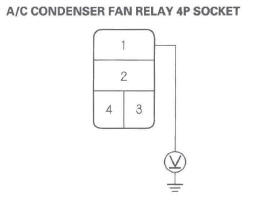
Is there battery voltage? YES-Go to step 4.
NO-Replace the under-hood fuse/relay box.
4. Connect the A/C condenser fan relay 4P socket terminals No.1 and No.2 with a jumper wire.
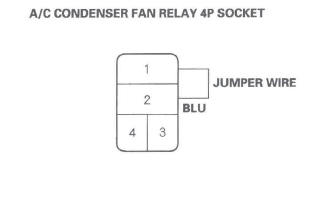
Does the A/C condenser fan run on high? YES-Go to step 5.
NO-Replace the under-hood fuse/relay box.
5. Disconnect the jumper wire.
6. Turn the ignition switch ON (II).
7. Measure the voltage between the A/C condenser fan relay 4P socket terminal No.4 and body ground.
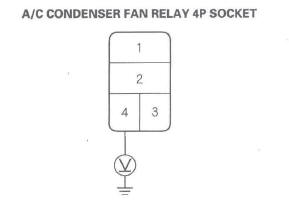
Is there battery voltage? YES-Go to step 8.
NO-Go to step 14.
8. Turn the ignition switch OFF.
9. Reinstall the A/C condenser fan relay.
10. Jump the SCS line with the HDS.
NOTE: This step must be done to protect the powertrain control module (PCM) from damage.
11. Disconnect PCM connector A (44P).
12. Connect the PCM connector A (44P) terminal No.5 to body ground with a jumper wire.
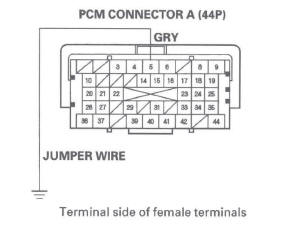
13. Turn the ignition switch ON (II).
Does the A/C condenser fan run on high? YES-Check for loose wires or poor connections at PCM connector A (44P) terminal No.5. If the connections are good, substitute a known-good PCM, and recheck. If the symptom/indication goes away, replace the original PCM.
NO-Repair open in the wire between the A/C condenser fan relay and the PCM.
14. Remove A/C diode B from the under-hood fuse/ relay box.
15. Turn the ignition switch ON (II).
16. Measure the voltage between the A/C diode B 2P socket terminal No.2 and body ground.
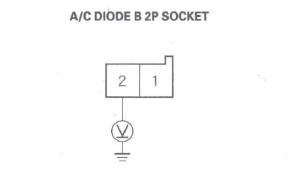
Is there battery voltage? YES-Go to step 17.
NO-Replace the under-hood fuse/relay box.
17. Using the diode setting ( ) on
a DVOM, check
for current flow in both directions between the A/C
diode B terminals No.1 and No.2.
) on
a DVOM, check
for current flow in both directions between the A/C
diode B terminals No.1 and No.2.
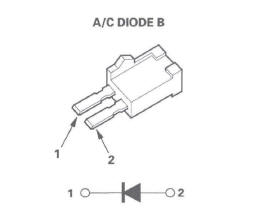
Is there current flow in only one direction? YES-Replace the under-hood fuse/relay box.
NO-Replace A/C diode B.
A/C Compressor Clutch Circuit Troubleshooting
NOTE:
- It is normal for the A/C compressor to turn off under certain conditions, such as low idle, high engine coolant temperature, hard acceleration, or high/low pressure.
- Do not use this troubleshooting procedure if the fans are also inoperative with the A/C on. Refer to the symptom troubleshooting index.
- Before doing any symptom troubleshooting, check for powertrain DTCs.
1. Check the No. 20 (7.5 A) fuse in the under-hood fuse/relay box, and the No. 36 (10 A) fuse in the under-dash fuse/relay box.
Are the fuses OK? YES-Go to step 2.
NO-Replace the fuses and recheck. If the fuses blow again, check for a short in the No. 20 (7.5 A) and No. 36 (10 A) fuses circuit.
2. Connect the HDS to the DLC.
3. Start the engine.
4. Turn on the A/C.
5. Check the A/C CLUTCH in the PGM-FI Data List with the HDS.
Is the A/C CLUTCH on? YES-Go to step 7.
NO-Go to step 6.
6. Using the HDS, confirm the following values in the PGM-FI Data List at idle.
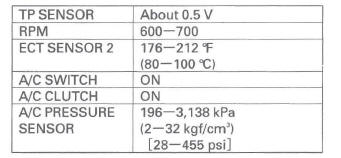
Are all the values within specifications? YES-Go to step 7.
NO-Troubleshoot the value that is not within the specifications.
7. Remove the A/C compressor clutch relay from the under-hood fuse/relay box, and test it.
Is the relay OK? YES-Go to step 8.
NO-Replace the A/C compressor clutch relay.
8. Measure the voltage between the A/C compressor clutch relay 4P socket terminal No. 1 and body ground.
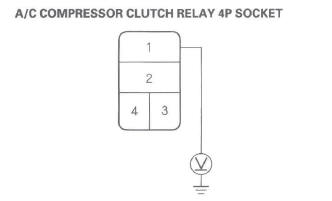
Is there battery voltage? YES-Go to step 9.
NO-Replace the under-hood fuse/relay box.
9. Connect the A/C compressor clutch relay 4P socket terminals No.1 and No.2 with a jumper wire.
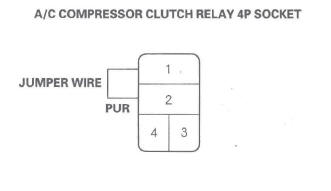
Does the A/C compressor clutch click? YES-Go to step 10.
NO-Go to step 19.
10. Disconnect the jumper wire.
11. Turn the ignition switch ON (II).
12. Measure the voltage between the A/C compressor clutch relay 4P socket terminal No.3 and body ground.
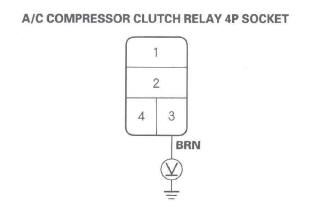
Is there battery voltage? YES-Go to step 13.
NO-Repair open in the wire between the No. 36 (10 A) fuse in the under-dash fuse/relay box and the A/C compressor clutch relay.
13. Turn the ignition switch OFF.
14. Reinstall the A/C compressor clutch relay.
15. Jump the SCS line with the HDS.
NOTE: This step must be done to protect the powertrain control module (PCM) from damage.
16. Disconnect PCM connector A (44P).
17. Connect the PCM connector A (44P) terminal No. 14 to body ground with a jumper wire. '
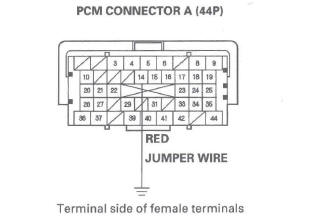
18. Turn the ignition switch ON (II).
Does the A/C compressor click? YES-Check for loose wires or poor connections at PCM connector A (44P). If the connections are good, check the PCM grounds. If the grounds are good, substitute a known-good PCM, and recheck. If the symptom/indication goes away, replace the original PCM.
NO-Repair open in the wire between the A/C compressor clutch relay and the PCM.
19. Disconnect the jumper wire.
20. Disconnect the A/C compressor clutch 3P connector.
21. Check for continuity between the A/C compressor clutch relay 4P socket terminal No.2 and the A/C compressor clutch 3P connector terminal No.3.
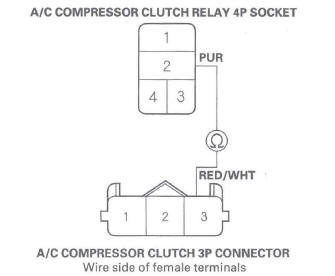
Is there continuity? YES-Check the A/C compressor clutch clearance, and the compressor clutch field coil. Repair as needed.
NO-Repair open in the wire between the A/C compressor clutch relay and the A/C compressor clutch.

